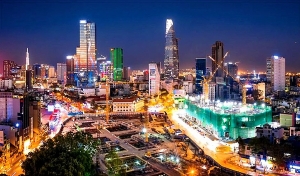Moody's assigns Ba2 rating to Vietnam on back of efficient economic policies
At the same time, Moody's also changed the outlook of Vietnam to stable from positive. The stable outlook reflects the balance of risks to the rating.
 |
According to the Ministry of Finance, the upgrade to Ba2 reflects the country's growing economic strengths relative to its peers and greater resilience to external macroeconomic shocks.
The international situation continues to be complicated, which has led to more than 30 credit downgrades around the world in the first eight months of the year. Vietnam is the only country in the Asia-Pacific region, and one of the four countries around the world, where Moody's has upgraded its national credit rating since early this year.
| Moody's expects the Vietnamese economy to continue to benefit from supply chain reconfiguration, export diversification, and continued inbound investment in manufacturing. The rating also reflects a sounder fiscal footing backed by contained borrowing costs, a conservative approach to fiscal policy, and improved government liquidity. |
Vietnam's economic strength is underpinned by its increasing competitiveness and integration with global value chains.
The increasing demand for Vietnamese exports throughout the pandemic underpinned the growing competitiveness of the nation's manufacturing sector, which has outperformed regional peers in the attraction of foreign direct investment (FDI) and has driven a rapid rise in per capita income.
Moody's expects Vietnam's centrality to multiple regional and bilateral trade agreements to reaffirm its entrenched position in global value chains.
Vietnam is a party to the Regional Comprehensive Economic Partnership, the Comprehensive and Progressive Agreement for Trans-Pacific Partnership, and bilateral Free Trade Agreements with South Korea, and more recently, with the European Union and the United Kingdom.
These trade agreements will strengthen Vietnam's competitive position in lower-value products such as footwear, garments, and agricultural goods while placing it firmly in higher-value-added regional tech supply chains for smartphones, computers, and other electronic products.
The improved fiscal policy is one of the main factors contributing to the upgrade decision. Specifically, fiscal policy effectiveness has improved, including a greater emphasis on medium-term budget planning and the deepening of domestic, low-cost financing sources.
The National Assembly has also lowered the statutory public debt ceiling to 60 per cent of GDP from 65 per cent to better anchor debt levels while preserving fiscal flexibility amid the ongoing economic recovery.
However, structural risks to this economic trajectory may emerge over the next 5-10 years as the existing stock of port, airport, electricity, and railway infrastructure and the working-age population – which will peak around 2035 – may be insufficient to absorb large-scale shifts in supply chains to Vietnam from China and other higher-wage production locations.
Moody's expects the Vietnamese authorities to seek to address these challenges through investment in education and worker training to support higher productivity and employment in higher value-added activities while targeting inflows of FDI into sectors and activities that lead to greater direct spillovers for domestic suppliers.
 | Moody's affirms Vietnam positive move in fiscal vigour Moody’s Investors Service (Moody's) has affirmed Vietnam’s long-term credit rating at Ba3 and raised its outlook for the country to "positive". |
 | Moody's takes rating actions on 15 Vietnamese banks Moody's Investors Service has affirmed the long-term local and foreign currency deposit ratings, and where applicable, the issuer and senior unsecured ratings of 15 banks in Vietnam at Ba3 positive. |
 | S&P Global raises Vietnam outlook to positive S&P Global Ratings has revised the outlook on its long-term ratings on Vietnam to positive from stable. |
What the stars mean:
★ Poor ★ ★ Promising ★★★ Good ★★★★ Very good ★★★★★ Exceptional
Related Contents
Latest News
More News
- Vietnam’s green transition demands collective financial action (December 15, 2025 | 12:00)
- VIR workshop highlights capital and policy for sustainable development (December 15, 2025 | 11:00)
- National Assembly approves pilot mechanisms to accelerate major projects in Hanoi (December 12, 2025 | 11:29)
- Vietnam eases policy approval requirements, simplifies foreign and outbound investments (December 11, 2025 | 17:53)
- Unpacking new momentum in Vietnam’s M&A market (December 10, 2025 | 09:59)
- Forum honours outstanding M&A deals, strategies, and advisory firms (December 09, 2025 | 18:22)
- Vietnam enters defining phase of M&A growth (December 09, 2025 | 17:00)
- Vietnam’s M&A market opens new opportunities amid strong economic momentum (December 09, 2025 | 15:00)
- Vietnam M&A Forum 2025: new position, new momentum (December 09, 2025 | 14:30)
- FDI in Vietnam jumps on additional capital and share purchases (December 09, 2025 | 13:56)

 Tag:
Tag:





















 Mobile Version
Mobile Version